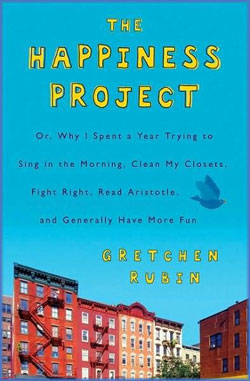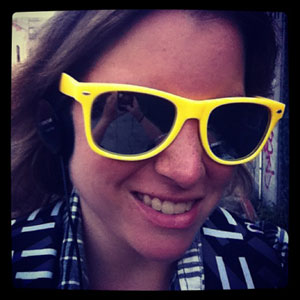
“I wasn’t as happy as I could be, and my life wasn’t going to change unless I made it change. In that single moment, with that realization, I decided to dedicate a year to trying to be happier.”-Gretchen Rubin, The Happiness Project
On Friday night, my co-worker joked that I had to take my glass half-full outlook and check it at the door. Then on Saturday afternoon, while wearing my yellow sunglasses, I purchased a pair of yellow pants, blue running shoes, an orange cardigan, and pink Bermuda shorts. That’s what I call optimism—but we can always have more—and we can always be happier.
In fact, when Gretchen Rubin took her bus ride and had her great epiphany on her yearlong quest for happiness—she was already happy—she just knew she could be happier.
Selfishly, I had picked up Rubin’s #1 New York Times Bestseller, THE HAPPINESS PROJECT, from Barnes and Noble just a few weeks ago because I was looking for inspiration and tips in regards to my own book project: one that also involves a yearlong quest—to become a professional amateur.
Pleasantly, I was surprised at how gratifying it felt to read about another person’s happiness. I’d been facing doubt over my own project this summer because I felt my angle may be all wrong, that I was too focused on myself, and that what I was doing was too egocentric. But this book about Rubin’s journey mesmerized me. In fact, upon reading her intro, I felt so inspired to put down her book for a few hours, and write my own intro. It was clear in the early moments, of Rubin’s story, (something I already had an inkling of knowledge about from stand up comedy) that happiness is contagious.
 As I continued reading through Rubin’s monthly experiences (for her project, she devoted each month to a new focus concept: For instance: March was focused on work—and April on Parenthood), I stumbled upon hard concrete facts that she weaved within her own personal stories:
As I continued reading through Rubin’s monthly experiences (for her project, she devoted each month to a new focus concept: For instance: March was focused on work—and April on Parenthood), I stumbled upon hard concrete facts that she weaved within her own personal stories:
For instance, did you know that hugs that last at least six seconds are the best? I didn’t. Rubin explains that six seconds “is the minimum time necessary to promote the flow of oxygen and serotonin, mood-boosting chemicals that promote bonding.”
She then dove into how her six-second hug with her husband was a crucial factor in helping to pass and resolve the tension that had just built through a small argument. Now, as someone who has always been a bit of an awkward hugger, I’ve decided to make my hugs a bit more intense and lengthy.
What I’ve taken from Rubin’s book is not only self-serving in regards to my own current quest, but also in regards to life: we can always be happier.
Now, please, excuse me while I go throw on my yellow sunglasses on this cloudy day.
Libby Segal is a New York City based associate producer, writer, and stand up comedian.